2014 NISSAN PATHFINDER HYBRID change wheel
[x] Cancel search: change wheelPage 546 of 571
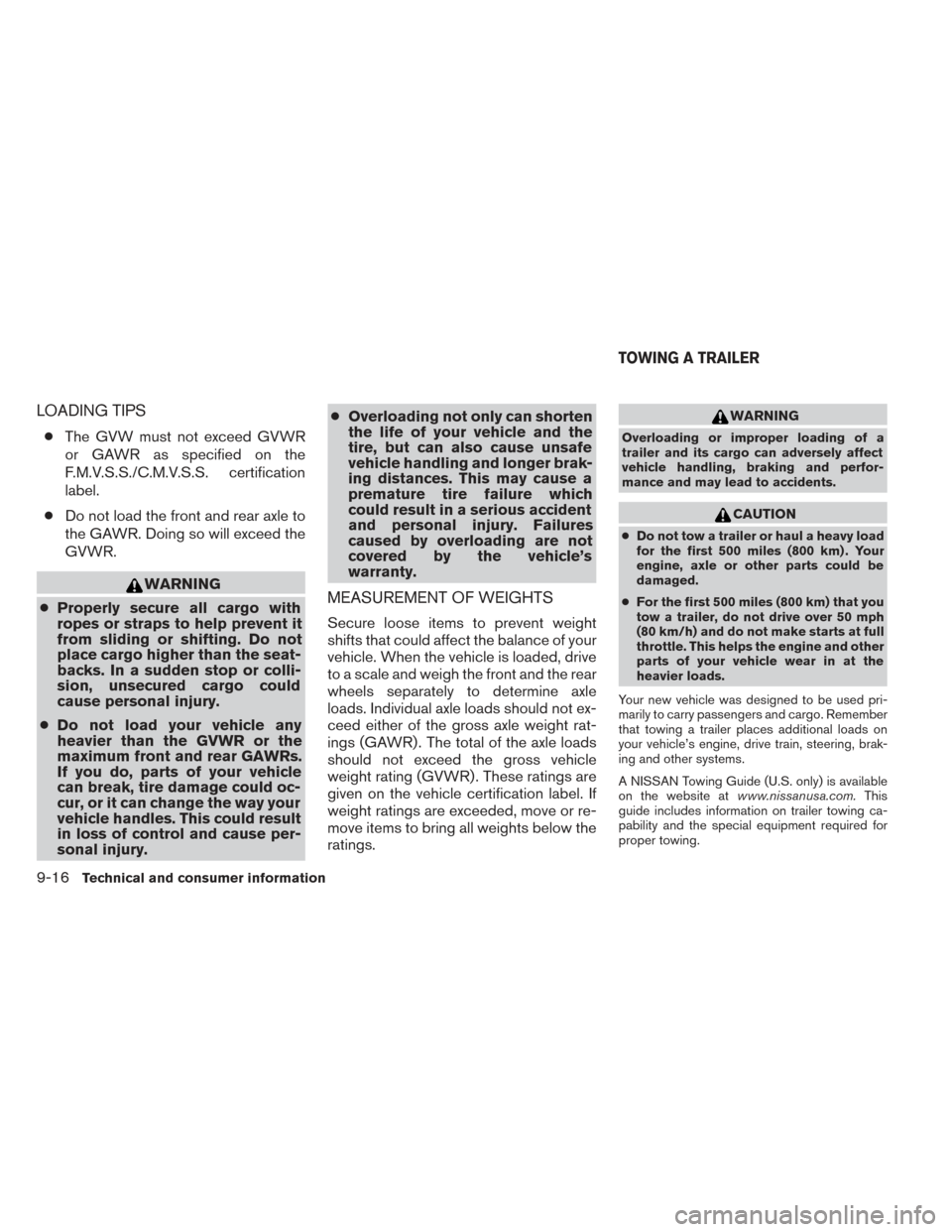
LOADING TIPS
●The GVW must not exceed GVWR
or GAWR as specified on the
F.M.V.S.S./C.M.V.S.S. certification
label.
● Do not load the front and rear axle to
the GAWR. Doing so will exceed the
GVWR.
WARNING
● Properly secure all cargo with
ropes or straps to help prevent it
from sliding or shifting. Do not
place cargo higher than the seat-
backs. In a sudden stop or colli-
sion, unsecured cargo could
cause personal injury.
● Do not load your vehicle any
heavier than the GVWR or the
maximum front and rear GAWRs.
If you do, parts of your vehicle
can break, tire damage could oc-
cur, or it can change the way your
vehicle handles. This could result
in loss of control and cause per-
sonal injury. ●
Overloading not only can shorten
the life of your vehicle and the
tire, but can also cause unsafe
vehicle handling and longer brak-
ing distances. This may cause a
premature tire failure which
could result in a serious accident
and personal injury. Failures
caused by overloading are not
covered by the vehicle’s
warranty.MEASUREMENT OF WEIGHTS
Secure loose items to prevent weight
shifts that could affect the balance of your
vehicle. When the vehicle is loaded, drive
to a scale and weigh the front and the rear
wheels separately to determine axle
loads. Individual axle loads should not ex-
ceed either of the gross axle weight rat-
ings (GAWR) . The total of the axle loads
should not exceed the gross vehicle
weight rating (GVWR) . These ratings are
given on the vehicle certification label. If
weight ratings are exceeded, move or re-
move items to bring all weights below the
ratings.
WARNING
Overloading or improper loading of a
trailer and its cargo can adversely affect
vehicle handling, braking and perfor-
mance and may lead to accidents.
CAUTION
● Do not tow a trailer or haul a heavy load
for the first 500 miles (800 km) . Your
engine, axle or other parts could be
damaged.
● For the first 500 miles (800 km) that you
tow a trailer, do not drive over 50 mph
(80 km/h) and do not make starts at full
throttle. This helps the engine and other
parts of your vehicle wear in at the
heavier loads.
Your new vehicle was designed to be used pri-
marily to carry passengers and cargo. Remember
that towing a trailer places additional loads on
your vehicle’s engine, drive train, steering, brak-
ing and other systems.
A NISSAN Towing Guide (U.S. only) is available
on the website at www.nissanusa.com. This
guide includes information on trailer towing ca-
pability and the special equipment required for
proper towing.
TOWING A TRAILER
9-16Technical and consumer information
Page 555 of 571
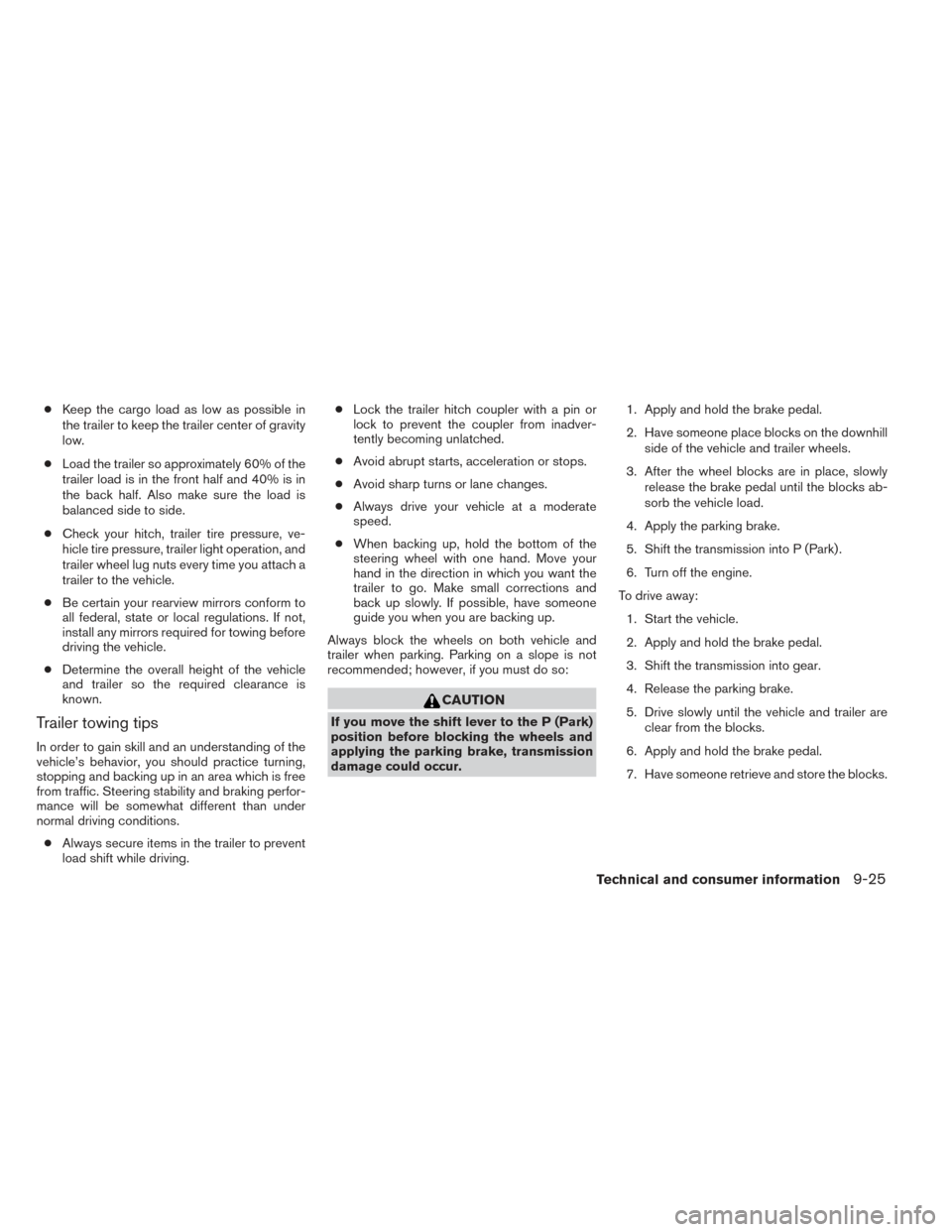
●Keep the cargo load as low as possible in
the trailer to keep the trailer center of gravity
low.
● Load the trailer so approximately 60% of the
trailer load is in the front half and 40% is in
the back half. Also make sure the load is
balanced side to side.
● Check your hitch, trailer tire pressure, ve-
hicle tire pressure, trailer light operation, and
trailer wheel lug nuts every time you attach a
trailer to the vehicle.
● Be certain your rearview mirrors conform to
all federal, state or local regulations. If not,
install any mirrors required for towing before
driving the vehicle.
● Determine the overall height of the vehicle
and trailer so the required clearance is
known.
Trailer towing tips
In order to gain skill and an understanding of the
vehicle’s behavior, you should practice turning,
stopping and backing up in an area which is free
from traffic. Steering stability and braking perfor-
mance will be somewhat different than under
normal driving conditions.
● Always secure items in the trailer to prevent
load shift while driving. ●
Lock the trailer hitch coupler with a pin or
lock to prevent the coupler from inadver-
tently becoming unlatched.
● Avoid abrupt starts, acceleration or stops.
● Avoid sharp turns or lane changes.
● Always drive your vehicle at a moderate
speed.
● When backing up, hold the bottom of the
steering wheel with one hand. Move your
hand in the direction in which you want the
trailer to go. Make small corrections and
back up slowly. If possible, have someone
guide you when you are backing up.
Always block the wheels on both vehicle and
trailer when parking. Parking on a slope is not
recommended; however, if you must do so:
CAUTION
If you move the shift lever to the P (Park)
position before blocking the wheels and
applying the parking brake, transmission
damage could occur. 1. Apply and hold the brake pedal.
2. Have someone place blocks on the downhill
side of the vehicle and trailer wheels.
3. After the wheel blocks are in place, slowly release the brake pedal until the blocks ab-
sorb the vehicle load.
4. Apply the parking brake.
5. Shift the transmission into P (Park) .
6. Turn off the engine.
To drive away: 1. Start the vehicle.
2. Apply and hold the brake pedal.
3. Shift the transmission into gear.
4. Release the parking brake.
5. Drive slowly until the vehicle and trailer are clear from the blocks.
6. Apply and hold the brake pedal.
7. Have someone retrieve and store the blocks.
Technical and consumer information9-25
Page 556 of 571
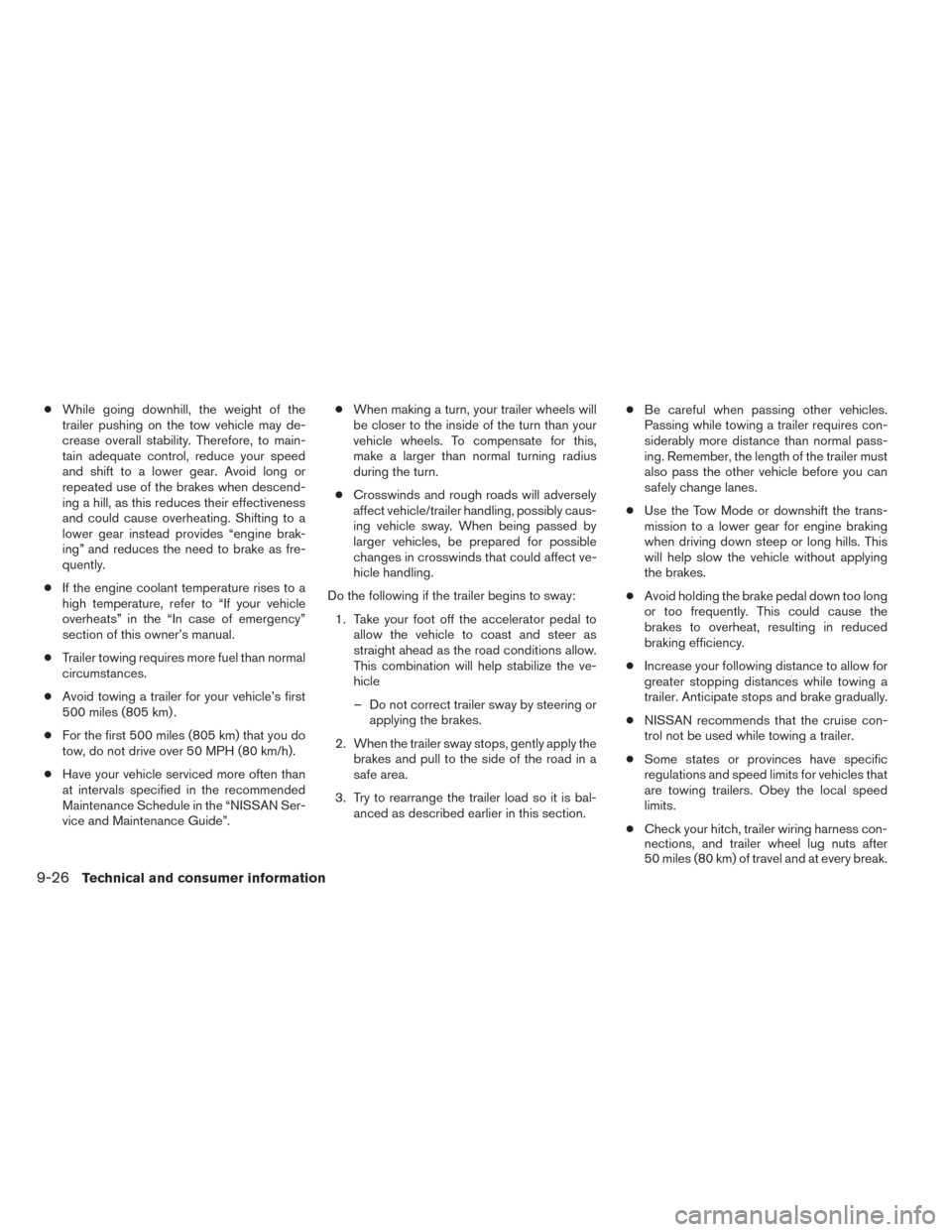
●While going downhill, the weight of the
trailer pushing on the tow vehicle may de-
crease overall stability. Therefore, to main-
tain adequate control, reduce your speed
and shift to a lower gear. Avoid long or
repeated use of the brakes when descend-
ing a hill, as this reduces their effectiveness
and could cause overheating. Shifting to a
lower gear instead provides “engine brak-
ing” and reduces the need to brake as fre-
quently.
● If the engine coolant temperature rises to a
high temperature, refer to “If your vehicle
overheats” in the “In case of emergency”
section of this owner’s manual.
● Trailer towing requires more fuel than normal
circumstances.
● Avoid towing a trailer for your vehicle’s first
500 miles (805 km) .
● For the first 500 miles (805 km) that you do
tow, do not drive over 50 MPH (80 km/h).
● Have your vehicle serviced more often than
at intervals specified in the recommended
Maintenance Schedule in the “NISSAN Ser-
vice and Maintenance Guide”. ●
When making a turn, your trailer wheels will
be closer to the inside of the turn than your
vehicle wheels. To compensate for this,
make a larger than normal turning radius
during the turn.
● Crosswinds and rough roads will adversely
affect vehicle/trailer handling, possibly caus-
ing vehicle sway. When being passed by
larger vehicles, be prepared for possible
changes in crosswinds that could affect ve-
hicle handling.
Do the following if the trailer begins to sway: 1. Take your foot off the accelerator pedal to allow the vehicle to coast and steer as
straight ahead as the road conditions allow.
This combination will help stabilize the ve-
hicle
– Do not correct trailer sway by steering or applying the brakes.
2. When the trailer sway stops, gently apply the brakes and pull to the side of the road in a
safe area.
3. Try to rearrange the trailer load so it is bal- anced as described earlier in this section. ●
Be careful when passing other vehicles.
Passing while towing a trailer requires con-
siderably more distance than normal pass-
ing. Remember, the length of the trailer must
also pass the other vehicle before you can
safely change lanes.
● Use the Tow Mode or downshift the trans-
mission to a lower gear for engine braking
when driving down steep or long hills. This
will help slow the vehicle without applying
the brakes.
● Avoid holding the brake pedal down too long
or too frequently. This could cause the
brakes to overheat, resulting in reduced
braking efficiency.
● Increase your following distance to allow for
greater stopping distances while towing a
trailer. Anticipate stops and brake gradually.
● NISSAN recommends that the cruise con-
trol not be used while towing a trailer.
● Some states or provinces have specific
regulations and speed limits for vehicles that
are towing trailers. Obey the local speed
limits.
● Check your hitch, trailer wiring harness con-
nections, and trailer wheel lug nuts after
50 miles (80 km) of travel and at every break.
9-26Technical and consumer information
Page 557 of 571
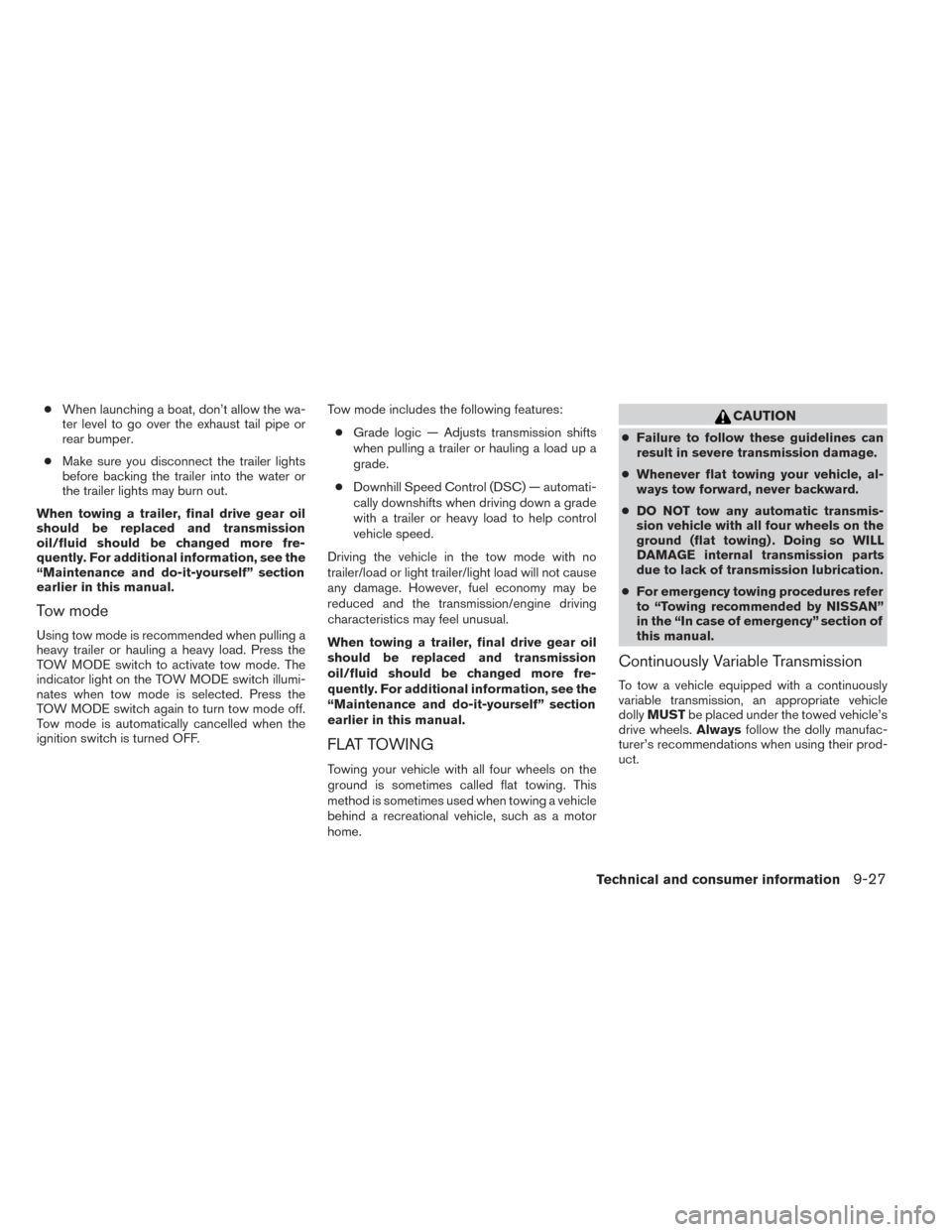
●When launching a boat, don’t allow the wa-
ter level to go over the exhaust tail pipe or
rear bumper.
● Make sure you disconnect the trailer lights
before backing the trailer into the water or
the trailer lights may burn out.
When towing a trailer, final drive gear oil
should be replaced and transmission
oil/fluid should be changed more fre-
quently. For additional information, see the
“Maintenance and do-it-yourself” section
earlier in this manual.
Tow mode
Using tow mode is recommended when pulling a
heavy trailer or hauling a heavy load. Press the
TOW MODE switch to activate tow mode. The
indicator light on the TOW MODE switch illumi-
nates when tow mode is selected. Press the
TOW MODE switch again to turn tow mode off.
Tow mode is automatically cancelled when the
ignition switch is turned OFF. Tow mode includes the following features:
● Grade logic — Adjusts transmission shifts
when pulling a trailer or hauling a load up a
grade.
● Downhill Speed Control (DSC) — automati-
cally downshifts when driving down a grade
with a trailer or heavy load to help control
vehicle speed.
Driving the vehicle in the tow mode with no
trailer/load or light trailer/light load will not cause
any damage. However, fuel economy may be
reduced and the transmission/engine driving
characteristics may feel unusual.
When towing a trailer, final drive gear oil
should be replaced and transmission
oil/fluid should be changed more fre-
quently. For additional information, see the
“Maintenance and do-it-yourself” section
earlier in this manual.
FLAT TOWING
Towing your vehicle with all four wheels on the
ground is sometimes called flat towing. This
method is sometimes used when towing a vehicle
behind a recreational vehicle, such as a motor
home.
CAUTION
● Failure to follow these guidelines can
result in severe transmission damage.
● Whenever flat towing your vehicle, al-
ways tow forward, never backward.
● DO NOT tow any automatic transmis-
sion vehicle with all four wheels on the
ground (flat towing) . Doing so WILL
DAMAGE internal transmission parts
due to lack of transmission lubrication.
● For emergency towing procedures refer
to “Towing recommended by NISSAN”
in the “In case of emergency” section of
this manual.
Continuously Variable Transmission
To tow a vehicle equipped with a continuously
variable transmission, an appropriate vehicle
dolly MUST be placed under the towed vehicle’s
drive wheels. Alwaysfollow the dolly manufac-
turer’s recommendations when using their prod-
uct.
Technical and consumer information9-27
Page 563 of 571
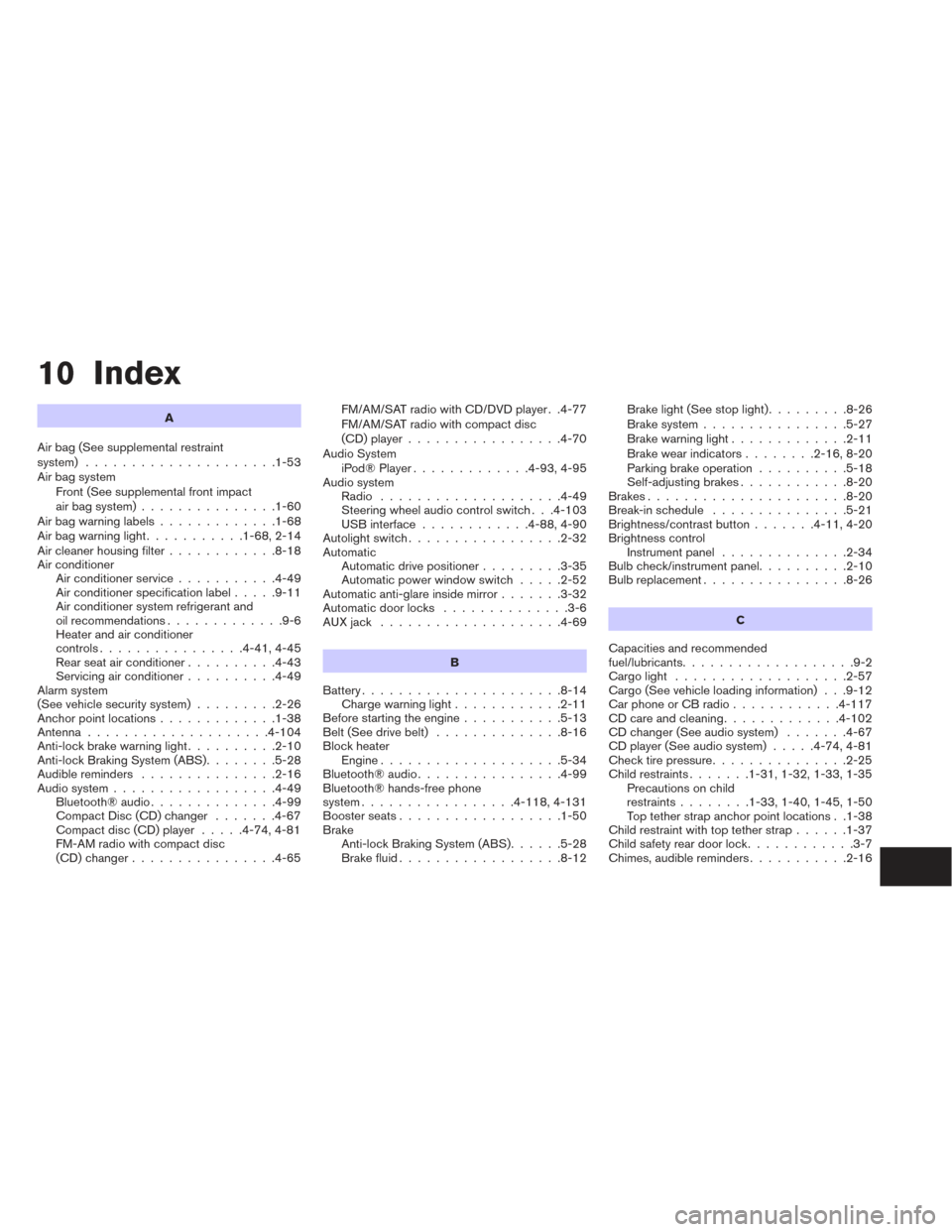
10 Index
A
Air bag (See supplemental restraint
system) .....................1-53
Air bag system Front (See supplemental front impact
air bag system) ...............1-60
Airbagwarninglabels.............1-68
Airbagwarninglight...........1-68,2-14
Air cleaner housing filter ............8-18
Air conditioner Air conditioner service ...........4-49
Air conditioner specification label .....9-11
Air conditioner system refrigerant and
oil recommendations .............9-6
Heater and air conditioner
controls................4-41,4-45
Rear seat air conditioner ..........4-43
Servicing air conditioner ..........4-49
Alarm system
(See vehicle security system) .........2-26
Anchor point locations .............1-38
Antenna....................4-104
Anti-lock brake warning light ..........2-10
Anti-lock Braking System (ABS) ........5-28
Audible reminders ...............2-16
Audio system ..................4-49
Bluetooth®audio..............4-99
Compact Disc (CD) changer .......4-67
Compact disc (CD) player .....4-74,4-81
FM-AM radio with compact disc
(CD) changer ................4-65 FM/AM/SAT radio with CD/DVD player . .4-77
FM/AM/SAT radio with compact disc
(CD) player
.................4-70
Audio System iPod®Player.............4-93,4-95
Audio system Radio ....................4-49
Steering wheel audio control switch . . .4-103
USB interface ............4-88,4-90
Autolight switch .................2-32
Automatic Automatic drive positioner .........3-35
Automatic power window switch .....2-52
Automatic anti-glare inside mirror .......3-32
Automatic door locks ..............3-6
AUXjack ....................4-69
B
Battery ......................8-14
Charge warning light ............2-11
Before starting the engine ...........5-13
Belt (See drive belt) ..............8-16
Block heater Engine ....................5-34
Bluetooth®audio................4-99
Bluetooth® hands-free phone
system .................4- 118, 4-131
Boosterseats..................1-50
Brake Anti-lock Braking System (ABS) ......5-28
Brake fluid ..................8-12 Brakelight(Seestoplight).........8-26
Brake system
................5-27
Brake warning light .............2-11
Brake wear indicators ........2-16,8-20
Parking brake operation ..........5-18
Self-adjusting brakes ............8-20
Brakes ......................8-20
Break-inschedule ...............5-21
Brightness/contrast button .......4-11,4-20
Brightness control Instrument panel ..............2-34
Bulb check/instrument panel ..........2-10
Bulbreplacement................8-26
C
Capacities and recommended
fuel/lubricants ...................9-2
Cargolight ...................2-57
Cargo
(See vehicle loading information) . . .9-12
Car phone or CB radio ............4-117
CD care and cleaning .............4-102
CD changer (See audio system) .......4-67
CD player (See audio system) .....4-74,4-81
Check tire pressure ...............2-25
Child restraints .......1-31,1-32,1-33,1-35
Precautions on child
restraints ........1-33,1-40,1-45,1-50
Top tether strap anchor point locations . .1-38
Child restraint with top tether strap ......1-37
Child safety rear door lock ............3-7
Chimes,audiblereminders...........2-16
Page 567 of 571
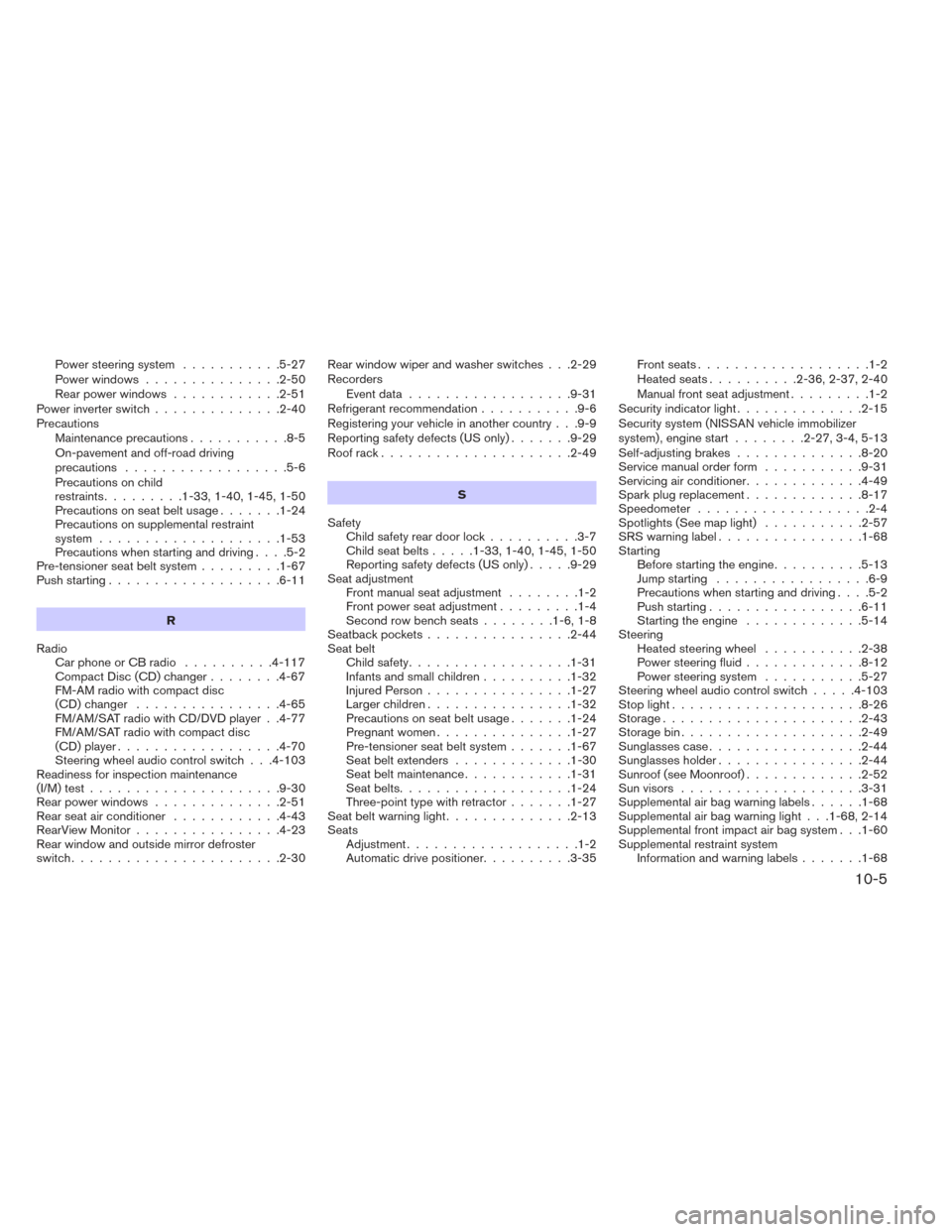
Power steering system...........5-27
Power windows ...............2-50
Rear power windows ............2-51
Powerinverterswitch..............2-40
Precautions Maintenanceprecautions...........8-5
On-pavement and off-road driving
precautions ..................5-6
Precautions on child
restraints .........1-33,1-40,1-45,1-50
Precautionsonseatbeltusage.......1-24
Precautions on supplemental restraint
system ....................1-53
Precautions when starting and driving ....5-2
Pre-tensioner seat belt system .........1-67
Push starting ...................6-11
R
Radio Car phone or CB radio ..........4-117
Compact Disc (CD) changer ........4-67
FM-AM radio with compact disc
(CD) changer ................4-65
FM/AM/SAT radio with CD/DVD player . .4-77
FM/AM/SAT radio with compact disc
(CD) player ..................4-70
Steering wheel audio control switch . . .4-103
Readiness for inspection maintenance
(I/M) test .....................9-30
Rear power windows ..............2-51
Rear seat air conditioner ............4-43
RearViewMonitor................4-23
Rear window and outside mirror defroster
switch .......................2-30 Rear window wiper and washer switches . . .2-29
Recorders
Eventdata..................9-31
Refrigerant recommendation ...........9-6
Registering your vehicle in another country . . .9-9
Reporting safety defects (US only) .......9-29
Roof rack .....................2-49
S
Safety Child safety rear door lock ..........3-7
Childseatbelts.....1-33,1-40,1-45,1-50
Reporting safety defects (US only) .....9-29
Seat adjustment Frontmanualseatadjustment ........1-2
Front power seat adjustment .........1-4
Second row bench seats ........1-6,1-8
Seatback pockets ................2-44
Seat belt Child safety ..................1-31
Infants and small children ..........1-32
Injured Person ................1-27
Largerchildren................1-32
Precautions on seat belt usage .......1-24
Pregnant women ...............1-27
Pre-tensioner seat belt system .......1-67
Seatbeltextenders .............1-30
Seatbeltmaintenance............1-31
Seatbelts...................1-24
Three-point type with retractor .......1-27
Seat belt warning light ..............2-13
Seats Adjustment ...................1-2
Automatic drive positioner ..........3-35 Frontseats...................1-2
Heated seats
..........2-36,2-37,2-40
Manual front seat adjustment .........1-2
Security indicator light ..............2-15
Security system (NISSAN vehicle immobilizer
system) , engine start ........2-27,3-4,5-13
Self-adjusting brakes ..............8-20
Service manual order form ...........9-31
Servicing air conditioner .............4-49
Spark plug replacement .............8-17
Speedometer ...................2-4
Spotlights(Seemaplight) ...........2-57
SRSwarninglabel................1-68
Starting Before
starting the engine ..........5-13
Jump starting .................6-9
Precautions when starting and driving ....5-2
Push starting .................6-11
Starting the engine .............5-14
Steering Heated steering wheel ...........2-38
Power steering fluid .............8-12
Power steering system ...........5-27
Steering wheel audio control switch .....4-103
Stoplight.....................8-26
Storage......................2-43
Storagebin....................2-49
Sunglasses case .................2-44
Sunglasses holder ................2-44
Sunroof (see Moonroof) .............2-52
Sun visors ....................3-31
Supplemental air bag warning labels ......1-68
Supplemental air bag warning light . . .1-68, 2-14
Supplemental front impact air bag system . . .1-60
Supplemental restraint system Information and warning labels .......1-68
10-5